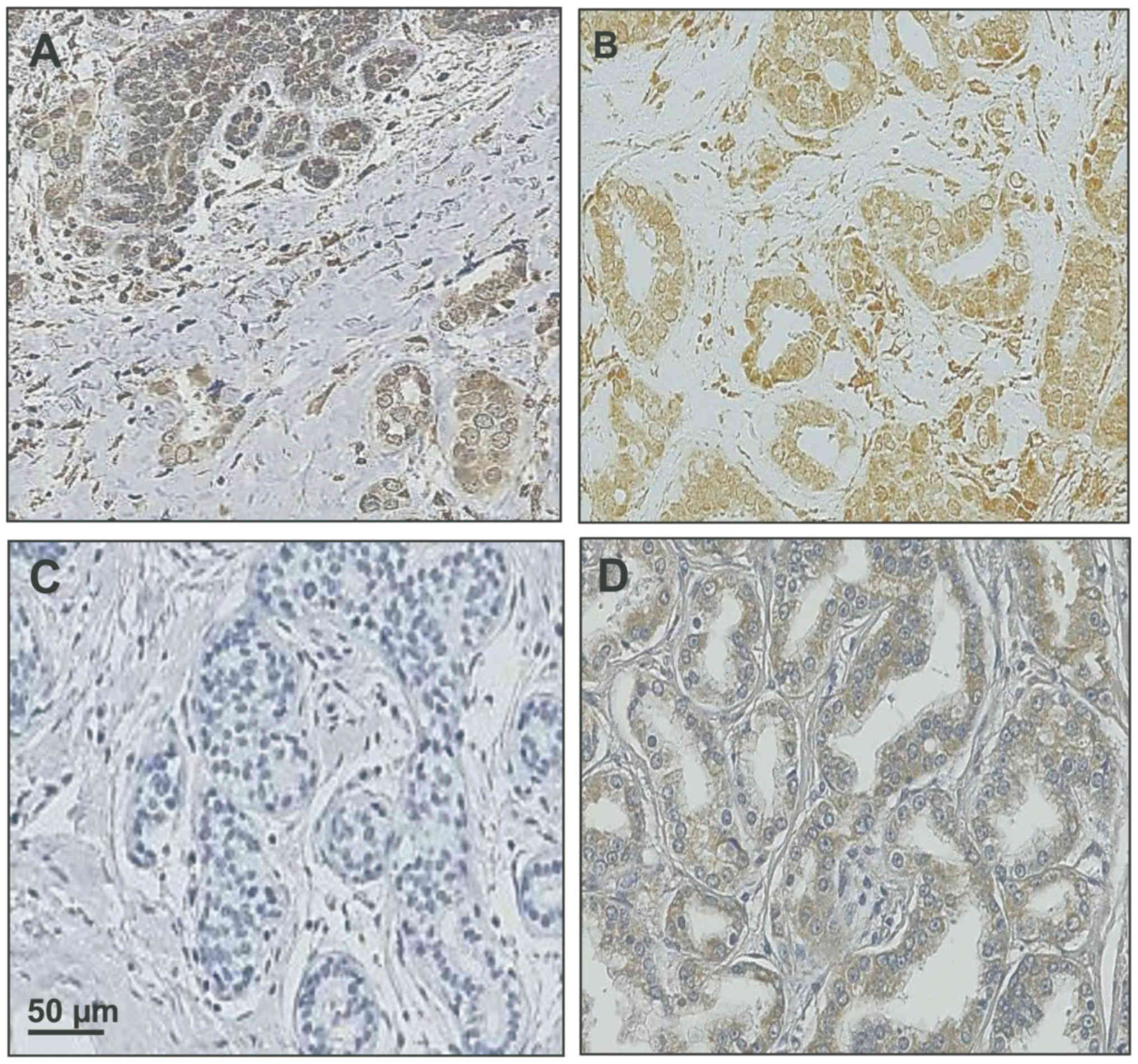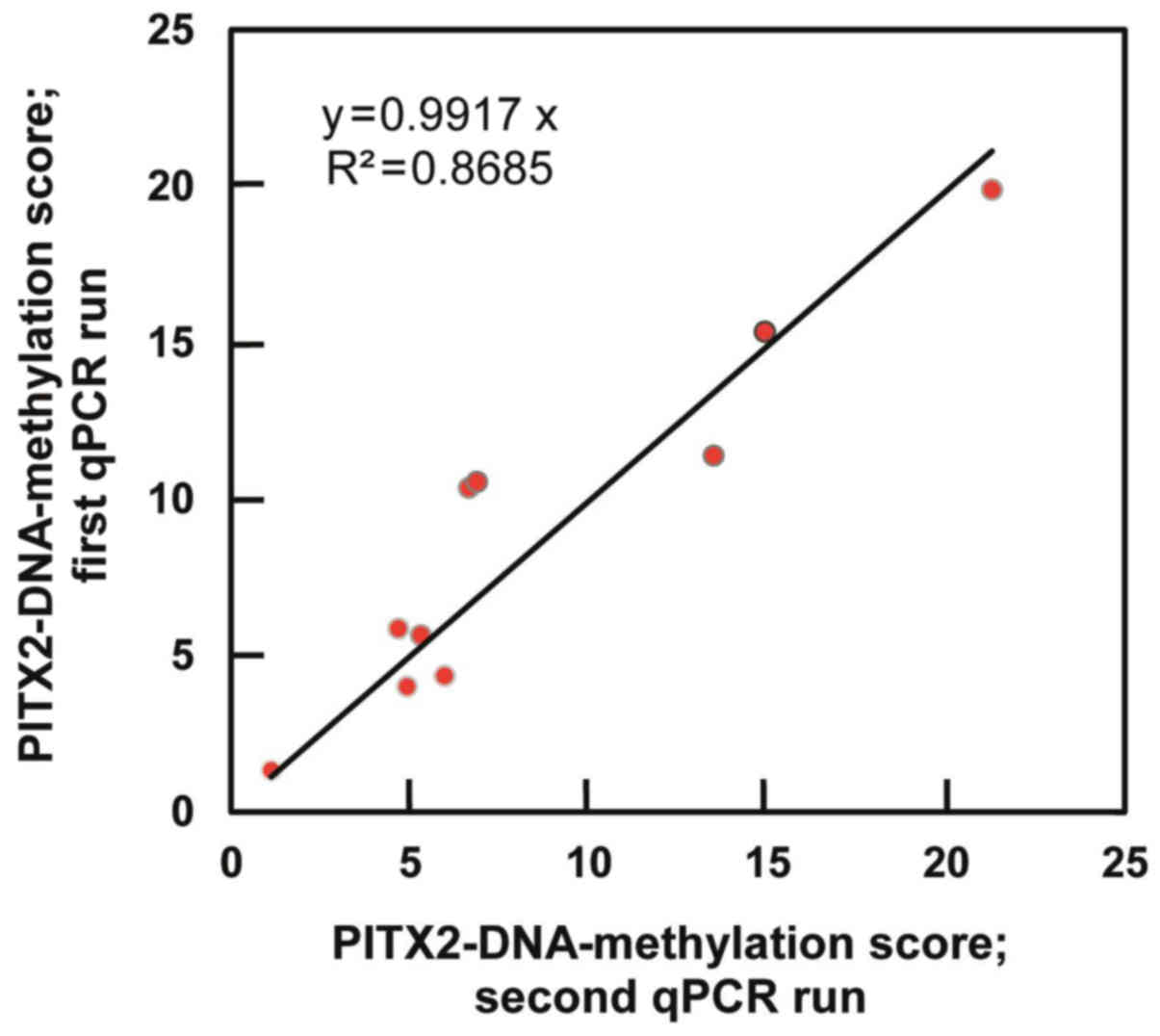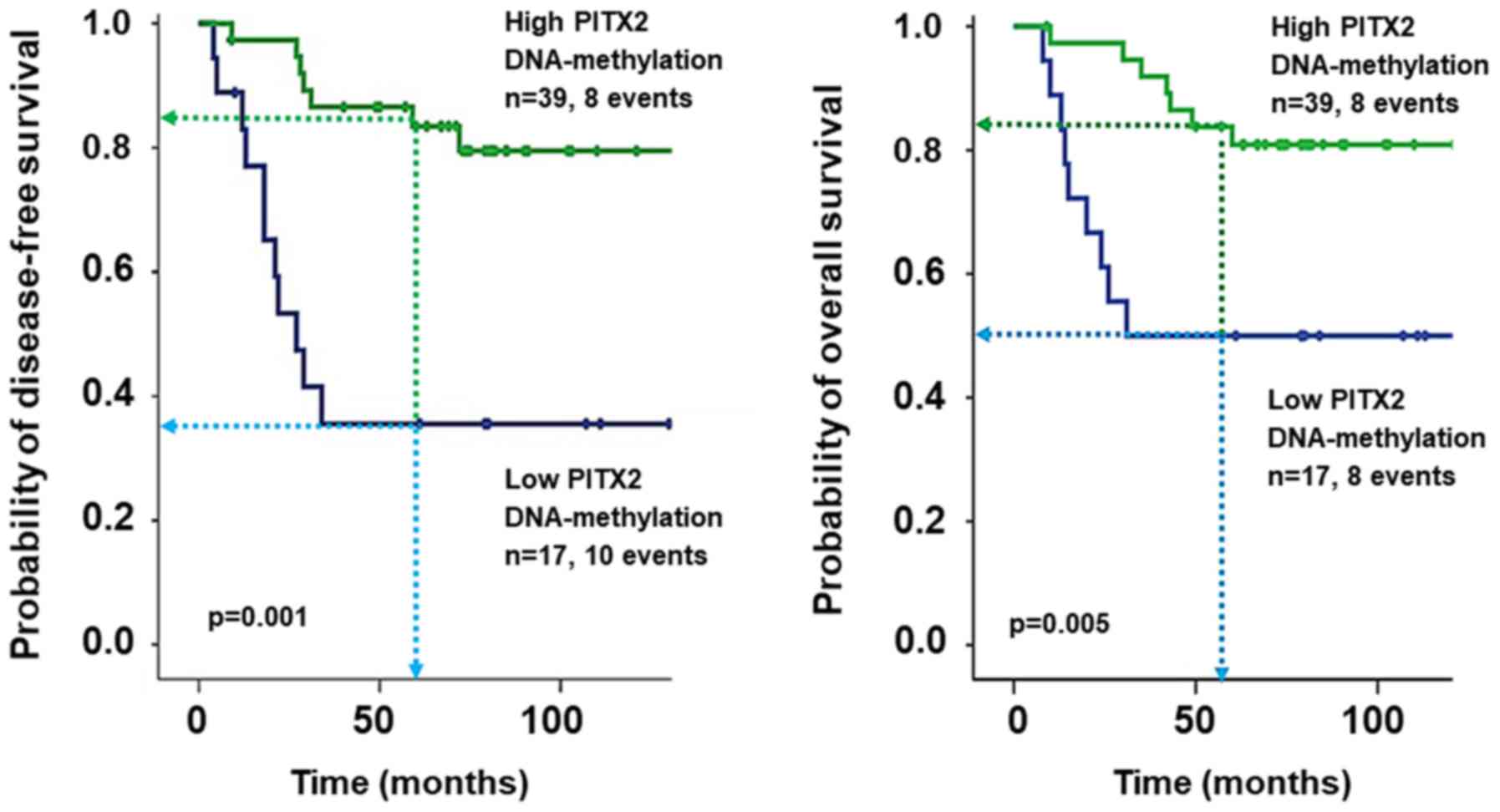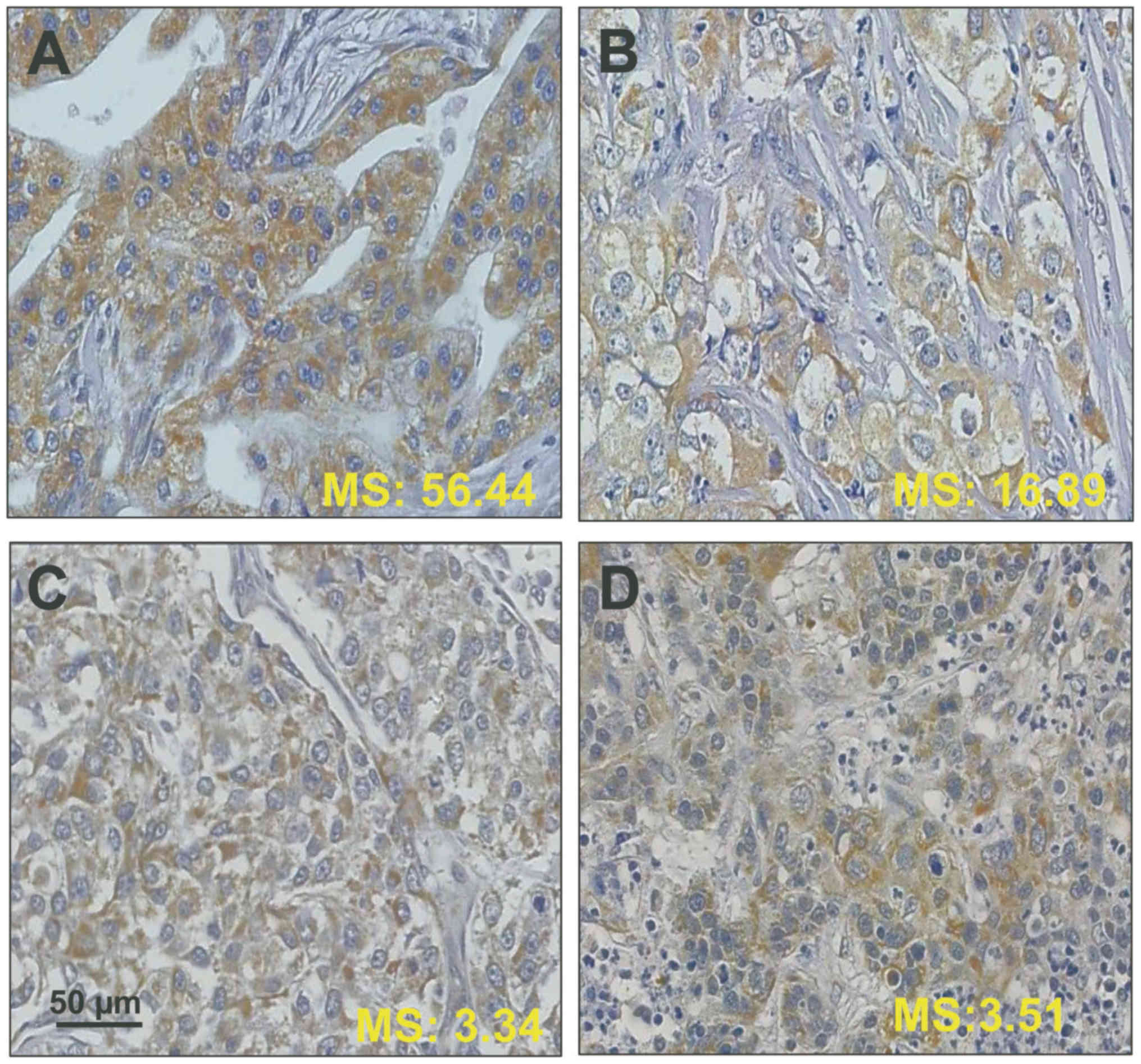PITX2 DNA-methylation predicts response to anthracycline-based adjuvant chemotherapy in triple-negative breast cancer patients
- Authors:
- Magdalena Absmaier
- Rudolf Napieralski
- Tibor Schuster
- Michaela Aubele
- Axel Walch
- Viktor Magdolen
- Julia Dorn
- Eva Gross
- Nadia Harbeck
- Aurelia Noske
- Marion Kiechle
- Manfred Schmitt
-
Affiliations: Department of Obstetrics and Gynecology, Technische Universität München, Munich, Germany, Institute of Medical Statistics and Epidemiology, Technische Universität München, Munich, Germany, Institute of Pathology, Helmholtz Zentrum Muenchen, Neuherberg, Germany, Breast Center, Klinikum der Ludwig Maximilians Universität München, Munich, Germany, Department of Pathology and Pathological Anatomy, Technische Universität München, Munich, Germany - Published online on: January 8, 2018 https://doi.org/10.3892/ijo.2018.4241
- Pages: 755-767
-
Copyright: © Absmaier et al. This is an open access article distributed under the terms of Creative Commons Attribution License.
This article is mentioned in:
Abstract
 |
 |
 |
 |
|
Wolff AC, Hammond ME, Hicks DG, Dowsett M, McShane LM, Allison KH, Allred DC, Bartlett JM, Bilous M, Fitzgibbons P, et al American Society of Clinical Oncology; College of American Pathologists: Recommendations for human epidermal growth factor receptor 2 testing in breast cancer: American Society of Clinical Oncology/College of American Pathologists clinical practice guideline update. J Clin Oncol. 31:3997–4013. 2013. View Article : Google Scholar : PubMed/NCBI | |
|
Bauer KR, Brown M, Cress RD, Parise CA and Caggiano V: Descriptive analysis of estrogen receptor (ER)-negative, progesterone receptor (PR)-negative, and HER2-negative invasive breast cancer, the so-called triple-negative phenotype: A population-based study from the California Cancer Registry. Cancer. 109:1721–1728. 2007. View Article : Google Scholar : PubMed/NCBI | |
|
Harbeck N and Gnant M: Breast cancer. Lancet. 389:1134–1150. 2017. View Article : Google Scholar | |
|
Jiang T, Shi W, Wali VB, Pongor LS, Li C, Lau R, Győrffy B, Lifton RP, Symmans WF, Pusztai L, et al: Predictors of chemo-sensitivity in triple negative breast cancer: An integrated genomic analysis. PLoS Med. 13:e10021932016. View Article : Google Scholar | |
|
Liedtke C and Kiesel L: Breast cancer molecular subtypes--modern therapeutic concepts for targeted therapy of a heterogeneous entity. Maturitas. 73:288–294. 2012. View Article : Google Scholar : PubMed/NCBI | |
|
Irshad S, Ellis P and Tutt A: Molecular heterogeneity of triple-negative breast cancer and its clinical implications. Curr Opin Oncol. 23:566–577. 2011. View Article : Google Scholar : PubMed/NCBI | |
|
Karn T, Pusztai L, Holtrich U, Iwamoto T, Shiang CY, Schmidt M, Müller V, Solbach C, Gaetje R, Hanker L, et al: Homogeneous datasets of triple negative breast cancers enable the identification of novel prognostic and predictive signatures. PLoS One. 6:e284032011. View Article : Google Scholar | |
|
Dent R, Trudeau M, Pritchard KI, Hanna WM, Kahn HK, Sawka CA, Lickley LA, Rawlinson E, Sun P and Narod SA: Triple-negative breast cancer: Clinical features and patterns of recurrence. Clin Cancer Res. 13:4429–4434. 2007. View Article : Google Scholar : PubMed/NCBI | |
|
Sørlie T, Perou CM, Tibshirani R, Aas T, Geisler S, Johnsen H, Hastie T, Eisen MB, van de Rijn M, Jeffrey SS, et al: Gene expression patterns of breast carcinomas distinguish tumor subclasses with clinical implications. Proc Natl Acad Sci USA. 98:10869–10874. 2001. View Article : Google Scholar : PubMed/NCBI | |
|
Lord CJ and Ashworth A: BRCAness revisited. Nat Rev Cancer. 16:110–120. 2016. View Article : Google Scholar : PubMed/NCBI | |
|
Spugnesi L, Gabriele M, Scarpitta R, Tancredi M, Maresca L, Gambino G, Collavoli A, Aretini P, Bertolini I, Salvadori B, et al: Germline mutations in DNA repair genes may predict neoadjuvant therapy response in triple negative breast patients. Genes Chromosomes Cancer. 55:915–924. 2016. View Article : Google Scholar : PubMed/NCBI | |
|
Mori H, Kubo M, Nishimura R, Osako T, Arima N, Okumura Y, Okido M, Yamada M, Kai M, Kishimoto J, et al: BRCAness as a biomarker for predicting prognosis and response to anthracycline-based adjuvant chemotherapy for patients with triple-negative breast cancer. PLoS One. 11:e01670162016. View Article : Google Scholar : PubMed/NCBI | |
|
Sharma P: Sharma. Oncologist. 21:1050–1062. 2016. View Article : Google Scholar : PubMed/NCBI | |
|
Lips EH, Mulder L, Oonk A, van der Kolk LE, Hogervorst FB, Imholz AL, Wesseling J, Rodenhuis S and Nederlof PM: Triple-negative breast cancer: BRCAness and concordance of clinical features with BRCA1-mutation carriers. Br J Cancer. 108:2172–2177. 2013. View Article : Google Scholar : PubMed/NCBI | |
|
Cardoso F, Harbeck N, Barrios CH, Bergh J, Cortés J, El Saghir N, Francis PA, Hudis CA, Ohno S, Partridge AH, et al: Research needs in breast cancer. Ann Oncol Nov. 28:208–217. 2017. | |
|
Fleisher B, Clarke C and Ait-Oudhia S: Current advances in biomarkers for targeted therapy in triple-negative breast cancer. Breast Cancer (Dove Med Press). 8:183–197. 2016. | |
|
Telli M: Optimizing chemotherapy in triple-negative breast cancer: The role of platinum. Am Soc Clin Oncol Educ Book. 33:e37–e42. 2014. View Article : Google Scholar | |
|
Guan X, Ma F, Fan Y, Zhu W, Hong R and Xu B: Platinum-based chemotherapy in triple-negative breast cancer: A systematic review and meta-analysis of randomized-controlled trials. Anticancer Drugs. 26:894–901. 2015. View Article : Google Scholar : PubMed/NCBI | |
|
Anders CK, Abramson V, Tan T and Dent R: The evolution of triple-negative breast cancer: From biology to novel therapeutics. Am Soc Clin Oncol Educ Book. 35:34–42. 2016. View Article : Google Scholar : PubMed/NCBI | |
|
Gerratana L, Fanotto V, Pelizzari G, Agostinetto E and Puglisi F: Do platinum salts fit all triple negative breast cancers. Cancer Treat Rev. 48:34–41. 2016. View Article : Google Scholar : PubMed/NCBI | |
|
Kern P, Kalisch A, Kolberg HC, Kimmig R, Otterbach F, von Minckwitz G, Sikov WM, Pott D and Kurbacher C: Neoadjuvant, anthracycline-free chemotherapy with carboplatin and docetaxel in triple-negative, early-stage breast cancer: A multicentric analysis of feasibility and rates of pathologic complete response. Chemotherapy. 59:387–394. 2013. View Article : Google Scholar | |
|
Zheng R, Han S, Duan C, Chen K, You Z, Jia J, Lin S, Liang L, Liu A, Long H, et al: Role of taxane and anthracycline combination regimens in the management of advanced breast cancer: a meta-analysis of randomized trials. Medicine. 94:e8032015. View Article : Google Scholar : PubMed/NCBI | |
|
Adium R and Liedtke C: Neoadjuvant therapy for patients with triple negative breast cancer (TNBC). Rev Recent Clin Trials. 12:73–80. 2017. View Article : Google Scholar | |
|
von Minckwitz G, Schneeweiss A, Loibl S, Salat C, Denkert C, Rezai M, Blohmer JU, Jackisch C, Paepke S, Gerber B, et al: Neoadjuvant carboplatin in patients with triple-negative and HER2-positive early breast cancer (GeparSixto; GBG 66): A randomised phase 2 trial. Lancet Oncol. 15:747–756. 2014. View Article : Google Scholar : PubMed/NCBI | |
|
Nabholtz JM, Abrial C, Mouret-Reynier MA, Dauplat MM, Weber B, Gligorov J, Forest AM, Tredan O, Vanlemmens L, Petit T, et al: Multicentric neoadjuvant phase II study of panitumumab combined with an anthracycline/taxane-based chemotherapy in operable triple-negative breast cancer: Identification of biologically defined signatures predicting treatment impact. Ann Oncol. 25:1570–1577. 2014. View Article : Google Scholar : PubMed/NCBI | |
|
McClendon AK, Dean JL, Rivadeneira DB, Yu JE, Reed CA, Gao E, Farber JL, Force T, Koch WJ and Knudsen ES: CDK4/6 inhibition antagonizes the cytotoxic response to anthracycline therapy. Cell Cycle. 11:2747–2755. 2012. View Article : Google Scholar : PubMed/NCBI | |
|
Reinisch M, von Minckwitz G, Harbeck N, Janni W, Kümmel S, Kaufmann M, Elling D, Nekljudova V and Loibl S: Side effects of standard adjuvant and neoadjuvant chemotherapy regimens according to age groups in primary breast cancer. Breast Care (Basel). 8:60–66. 2013. View Article : Google Scholar | |
|
Baylin SB and Jones PA: Epigenetic determinants of cancer. Cold Spring Harb Perspect Biol. 8:82016. View Article : Google Scholar | |
|
Wu Y, Sarkissyan M and Vadgama JV: Epigenetics in breast and prostate cancer. Methods Mol Biol. 1238:425–466. 2015. View Article : Google Scholar : | |
|
Jovanovic J, Rønneberg JA, Tost J and Kristensen V: The epigenetics of breast cancer. Mol Oncol. 4:242–254. 2010. View Article : Google Scholar : PubMed/NCBI | |
|
Basse C and Arock M: The increasing roles of epigenetics in breast cancer: Implications for pathogenicity, biomarkers, prevention and treatment. Int J Cancer. 137:2785–2794. 2015. View Article : Google Scholar | |
|
Yang X, Lay F, Han H and Jones PA: Targeting DNA methylation for epigenetic therapy. Trends Pharmacol Sci. 31:536–546. 2010. View Article : Google Scholar : PubMed/NCBI | |
|
Jones PA: Jones. J Clin Invest. 124:14–16. 2014. View Article : Google Scholar : PubMed/NCBI | |
|
Shiratori H, Yashiro K, Shen MM and Hamada H: Conserved regulation and role of Pitx2 in situs-specific morphogenesis of visceral organs. Development. 133:3015–3025. 2006. View Article : Google Scholar : PubMed/NCBI | |
|
Wilting J and Hagedorn M: Left-right asymmetry in embryonic development and breast cancer: Common molecular determinants. Curr Med Chem. 18:5519–5527. 2011. View Article : Google Scholar | |
|
Jezkova E, Kajo K, Zubor P, Grendar M, Malicherova B, Mendelova A, Dokus K, Lasabova Z, Plank L and Danko J: Methylation in promoter regions of PITX2 and RASSF1A genes in association with clinicopathological features in breast cancer patients. Tumour Biol. 37:15707–15718. 2016. View Article : Google Scholar | |
|
Martens JW, Margossian AL, Schmitt M, Foekens J and Harbeck N: DNA methylation as a biomarker in breast cancer. Future Oncol. 5:1245–1256. 2009. View Article : Google Scholar : PubMed/NCBI | |
|
Maier S, Nimmrich I, Koenig T, Eppenberger-Castori S, Bohlmann I, Paradiso A, Spyratos F, Thomssen C, Mueller V, Nährig J, et al European Organisation for Research and Treatment of Cancer (EORTC) PathoBiology group: DNA-methylation of the homeodomain transcription factor PITX2 reliably predicts risk of distant disease recurrence in tamoxifen-treated, node-negative breast cancer patients--Technical and clinical validation in a multi-centre setting in collaboration with the European Organisation for Research and Treatment of Cancer (EORTC) PathoBiology group. Eur J Cancer. 43:1679–1686. 2007. View Article : Google Scholar : PubMed/NCBI | |
|
Harbeck N, Nimmrich I, Hartmann A, Ross JS, Cufer T, Grützmann R, Kristiansen G, Paradiso A, Hartmann O, Margossian A, et al: Multicenter study using paraffin-embedded tumor tissue testing PITX2 DNA methylation as a marker for outcome prediction in tamoxifen-treated, node-negative breast cancer patients. J Clin Oncol. 26:5036–5042. 2008. View Article : Google Scholar : PubMed/NCBI | |
|
Hartmann O, Spyratos F, Harbeck N, Dietrich D, Fassbender A, Schmitt M, Eppenberger-Castori S, Vuaroqueaux V, Lerebours F, Welzel K, et al: DNA methylation markers predict outcome in node-positive, estrogen receptor-positive breast cancer with adjuvant anthracycline-based chemotherapy. Clin Cancer Res. 15:315–323. 2009. View Article : Google Scholar : PubMed/NCBI | |
|
Nimmrich I, Sieuwerts AM, Meijer-van Gelder ME, Schwope I, Bolt-de Vries J, Harbeck N, Koenig T, Hartmann O, Kluth A, Dietrich D, et al: DNA hypermethylation of PITX2 is a marker of poor prognosis in untreated lymph node-negative hormone receptor-positive breast cancer patients. Breast Cancer Res Treat. 111:429–437. 2008. View Article : Google Scholar | |
|
Kumar P and Aggarwal R: An overview of triple-negative breast cancer. Arch Gynecol Obstet. 293:247–269. 2016. View Article : Google Scholar | |
|
Loibl S, Denkert C and von Minckwitz G: Neoadjuvant treatment of breast cancer - Clinical and research perspective. Breast. 24(Suppl 2): S73–S77. 2015. View Article : Google Scholar | |
|
Liedtke C and Rody A: New treatment strategies for patients with triple-negative breast cancer. Curr Opin Obstet Gynecol. 27:77–84. 2015. View Article : Google Scholar | |
|
Yfanti C, Mengele K, Gkazepis A, Weirich G, Giersig C, Kuo WL, Tang WJ, Rosner M and Schmitt M: Expression of metalloprotease insulin-degrading enzyme insulysin in normal and malignant human tissues. Int J Mol Med. 22:421–431. 2008.PubMed/NCBI | |
|
Schmitt M, Mengele K, Schueren E, Sweep FC, Foekens JA, Brünner N, Laabs J, Malik A and Harbeck N; European Organisation for Research and Treatment of Cancer Pathobiology Group: European Organisation for Research and Treatment of Cancer (EORTC) Pathobiology Group standard operating procedure for the preparation of human tumour tissue extracts suited for the quantitative analysis of tissue-associated biomarkers. Eur J Cancer. 43:835–844. 2007. View Article : Google Scholar : PubMed/NCBI | |
|
McShane LM, Altman DG, Sauerbrei W, Taube SE, Gion M and Clark GM; Statistics Subcommittee of the NCI-EORTC Working Group on Cancer Diagnostics: Reporting recommendations for tumor marker prognostic studies (REMARK). J Natl Cancer Inst. 97:1180–1184. 2005. View Article : Google Scholar : PubMed/NCBI | |
|
Altman DG, McShane LM, Sauerbrei W and Taube SE: Reporting recommendations for tumor marker prognostic studies REMARK. Explanation and elaboration. PLoS Med. 9:e10012162012. View Article : Google Scholar | |
|
Hothorn T: Maxstat: maximally selected rank statistics. R package version 0.7-14. | |
|
Team RD CR: A language and environment for statistical computing. R Foundation for Statistical Computing Vienna Austria: 2012 | |
|
Blum M, Feistel K, Thumberger T and Schweickert A: The evolution and conservation of left-right patterning mechanisms. Development. 141:1603–1613. 2014. View Article : Google Scholar : PubMed/NCBI | |
|
Tabin CJ: Tabin. Cell. 127:27–32. 2006. View Article : Google Scholar : PubMed/NCBI | |
|
Levin M: Levin. Mech Dev. 122:3–25. 2005. View Article : Google Scholar | |
|
Paska AV and Hudler P: Aberrant methylation patterns in cancer: A clinical view. Biochem Med (Zagreb). 25:161–176. 2015. View Article : Google Scholar | |
|
Ahmed D, Danielsen SA, Aagesen TH, Bretthauer M, Thiis-Evensen E, Hoff G, Rognum TO, Nesbakken A, Lothe RA and Lind GE: A tissue-based comparative effectiveness analysis of biomarkers for early detection of colorectal tumors. Clin Transl Gastroenterol. 3:e272012. View Article : Google Scholar | |
|
Berghoff AS, Hainfellner JA, Marosi C and Preusser M: Assessing MGMT methylation status and its current impact on treatment in glioblastoma. CNS Oncol. 4:47–52. 2015. View Article : Google Scholar : PubMed/NCBI | |
|
Darwiche K, Zarogoulidis P, Baehner K, Welter S, Tetzner R, Wohlschlaeger J, Theegarten D, Nakajima T and Freitag L: Assessment of SHOX2 methylation in EBUS-TBNA specimen improves accuracy in lung cancer staging. Ann Oncol. 24:2866–2870. 2013. View Article : Google Scholar : PubMed/NCBI | |
|
Dietrich D, Jung M, Puetzer S, Leisse A, Holmes EE, Meller S, Uhl B, Schatz P, Ivascu C and Kristiansen G: Diagnostic and prognostic value of SHOX2 and SEPT9 DNA methylation and cytology in benign, paramalignant and malignant pleural effusions. PLoS One. 8:e842252013. View Article : Google Scholar | |
|
Ilse P, Biesterfeld S, Pomjanski N, Wrobel C and Schramm M: Analysis of SHOX2 methylation as an aid to cytology in lung cancer diagnosis. Cancer Genomics Proteomics. 11:251–258. 2014.PubMed/NCBI | |
|
Székely B, Silber AL and Pusztai L: New therapeutic strategies for triple-negative breast cancer. Oncology (Williston Park). 31:130–137. 2017. | |
|
Fung FK, Chan DW, Liu VW, Leung TH, Cheung AN and Ngan HY: Increased expression of PITX2 transcription factor contributes to ovarian cancer progression. PLoS One. 7:e370762012. View Article : Google Scholar : PubMed/NCBI | |
|
Kapoor S: Kapoor. APMIS. 121:10112013. View Article : Google Scholar | |
|
Liu Y, Huang Y and Zhu GZ: Cyclin A1 is a transcriptional target of PITX2 and overexpressed in papillary thyroid carcinoma. Mol Cell Biochem. 384:221–227. 2013. View Article : Google Scholar : PubMed/NCBI | |
|
Toyota M, Kopecky KJ, Toyota MO, Jair KW, Willman CL and Issa JP: Methylation profiling in acute myeloid leukemia. Blood. 97:2823–2829. 2001. View Article : Google Scholar : PubMed/NCBI | |
|
Uhl B, Gevensleben H, Tolkach Y, Sailer V, Majores M, Jung M, Meller S, Stein J, Ellinger J, Dietrich D, et al: PITX2 DNA Methylation as biomarker for individualized risk assessment of prostate cancer in core biopsies. J Mol Diagn. 19:107–114. 2017. View Article : Google Scholar | |
|
Wang Q, Li J, Wu W, Shen R, Jiang H, Qian Y, Tang Y, Bai T, Wu S, Wei L, et al: Smad4-dependent suppressor pituitary homeobox 2 promotes PPP2R2A-mediated inhibition of Akt pathway in pancreatic cancer. Oncotarget. 7:11208–11222. 2016.PubMed/NCBI | |
|
Zhang JX, Chen ZH, Xu Y, Chen JW, Weng HW, Yun M, Zheng ZS, Chen C, Wu BL, Li EM, et al: Downregulation of microRNA-644a promotes esophageal squamous cell carcinoma aggressiveness and stem cell-like phenotype via dysregulation of PITX2. Clin Cancer Res. 23:298–310. 2017. View Article : Google Scholar | |
|
Zhang JX, Tong ZT, Yang L, Wang F, Chai HP, Zhang F, Xie MR, Zhang AL, Wu LM, Hong H, et al: PITX2: A promising predictive biomarker of patients' prognosis and chemoradioresistance in esophageal squamous cell carcinoma. Int J Cancer. 132:2567–2577. 2013. View Article : Google Scholar | |
|
Sailer V, Gevensleben H, Dietrich J, Goltz D, Kristiansen G, Bootz F and Dietrich D: Clinical performance validation of PITX2 DNA methylation as prognostic biomarker in patients with head and neck squamous cell carcinoma. PLoS One. 12:e01794122017. View Article : Google Scholar : PubMed/NCBI | |
|
López JI, Angulo JC, Martín A, Sánchez-Chapado M, González-Corpas A, Colás B and Ropero S: A DNA hypermethylation profile reveals new potential biomarkers for the evaluation of prognosis in urothelial bladder cancer. APMIS. 125:787–796. 2017. View Article : Google Scholar : PubMed/NCBI | |
|
Harris LN, Ismaila N, McShane LM, Andre F, Collyar DE, Gonzalez-Angulo AM, Hammond EH, Kuderer NM, Liu MC, Mennel RG, et al: American Society of Clinical Oncology: Use of biomarkers to guide decisions on adjuvant systemic therapy for women with early-stage invasive breast cancer: American Society of Clinical Oncology Clinical Practice Guideline. J Clin Oncol. 34:1134–1150. 2016. View Article : Google Scholar : PubMed/NCBI | |
|
Wan Abdul, Rahman WF, Fauzi MH and Jaafar H: Expression of DNA methylation marker of paired-like homeodomain transcription factor 2 and growth receptors in invasive ductal carcinoma of the breast. Asian Pac J Cancer Prev. 15:8441–8445. 2014. View Article : Google Scholar | |
|
Bologna-Molina R, Mikami T, Pereira-Prado V, Pires FR, Carlos-Bregni R and Mosqueda-Taylor A: Primordial odonto-genic tumor: An immunohistochemical profile. Med Oral Patol Oral Cir Bucal. 22:e314-e3232017. | |
|
Huang Y, Guigon CJ, Fan J, Cheng SY and Zhu GZ: Pituitary homeobox 2 (PITX2) promotes thyroid carcinogenesis by activation of cyclin D2. Cell Cycle. 9:1333–1341. 2010. View Article : Google Scholar : PubMed/NCBI | |
|
Denkert C, Liedtke C, Tutt A and von Minckwitz G: Molecular alterations in triple-negative breast cancer-the road to new treatment strategies. Lancet. 389:2430–2442. 2016. View Article : Google Scholar : PubMed/NCBI | |
|
Lehmann BD, Bauer JA, Chen X, Sanders ME, Chakravarthy AB, Shyr Y and Pietenpol JA: Identification of human triple-negative breast cancer subtypes and preclinical models for selection of targeted therapies. J Clin Invest. 121:2750–2767. 2011. View Article : Google Scholar : PubMed/NCBI | |
|
Ring BZ, Hout DR, Morris SW, Lawrence K, Schweitzer BL, Bailey DB, Lehmann BD, Pietenpol JA and Seitz RS: Generation of an algorithm based on minimal gene sets to clinically subtype triple negative breast cancer patients. BMC Cancer. 16:1432016. View Article : Google Scholar : PubMed/NCBI | |
|
Bianchini G, Balko JM, Mayer IA, Sanders ME and Gianni L: Triple-negative breast cancer: Challenges and opportunities of a heterogeneous disease. Nat Rev Clin Oncol. 13:674–690. 2016. View Article : Google Scholar : PubMed/NCBI | |
|
Yadav BS, Sharma SC, Chanana P and Jhamb S: Systemic treatment strategies for triple-negative breast cancer. World J Clin Oncol. 5:125–133. 2014. View Article : Google Scholar : PubMed/NCBI | |
|
Burstein HJ: Patients with triple negative breast cancer: Is there an optimal adjuvant treatment? Breast. 22(Suppl 2): S147–S148. 2013. View Article : Google Scholar : PubMed/NCBI | |
|
Christenson ES, James T, Agrawal V and Park BH: Use of biomarkers for the assessment of chemotherapy-induced cardiac toxicity. Clin Biochem. 48:223–235. 2015. View Article : Google Scholar : | |
|
Basso SM, Santeufemia DA, Fadda GM, Tozzoli R, D'Aurizio F and Lumachi F: Advances in the treatment of triple-negative early breast cancer. Med Chem. 12:268–272. 2016. View Article : Google Scholar | |
|
Wahba HA and El-Hadaad HA: Current approaches in treatment of triple-negative breast cancer. Cancer Biol Med. 12:106–116. 2015.PubMed/NCBI | |
|
Yao H, He G, Yan S, Chen C, Song L, Rosol TJ and Deng X: Triple-negative breast cancer: Is there a treatment on the horizon. Oncotarget. 8:1913–1924. 2017. | |
|
Locatelli MA, Curigliano G and Eniu A: Extended adjuvant chemotherapy in triple-negative breast cancer. Breast Care (Basel). 12:152–158. 2017. View Article : Google Scholar | |
|
Liedtke C, Thill M, Jackisch C, Thomssen C, Müller V and Janni W: AGO Recommendations for the diagnosis and treatment of patients with early breast cancer: Update. Breast Care (Basel). 12. pp. 172–183. 2017, View Article : Google Scholar | |
|
Mori H, Kubo M, Nishimura R, Osako T, Arima N, Okumura Y, Okido M, Yamada M, Kai M, Kishimoto J, et al: BRCAness as a biomarker for predicting prognosis and response to anthracycline-based adjuvant chemotherapy for patients with triple-negative breast cancer. PLoS One. 11:e01670162016. View Article : Google Scholar : PubMed/NCBI | |
|
Bouchalova K, Svoboda M, Kharaishvili G, Vrbkova J, Bouchal J, Trojanec R, Koudelakova V, Radova L, Cwiertka K, Hajduch M, et al: BCL2 is an independent predictor of outcome in basal-like triple-negative breast cancers treated with adjuvant anthracycline-based chemotherapy. Tumour Biol. 36:4243–4252. 2015. View Article : Google Scholar : PubMed/NCBI | |
|
Duffy MJ, Napieralski R, Martens JW, Span PN, Spyratos F, Sweep FC, Brunner N, Foekens JA and Schmitt M; EORTC PathoBiology Group: Methylated genes as new cancer biomarkers. Eur J Cancer. 45:335–346. 2009. View Article : Google Scholar : PubMed/NCBI | |
|
Pillai SG, Dasgupta N, Siddappa CM, Watson MA, Fleming T, Trinkaus K and Aft R: Paired-like Homeodomain Transcription factor 2 expression by breast cancer bone marrow disseminated tumor cells is associated with early recurrent disease development. Breast Cancer Res Treat. 153:507–517. 2015. View Article : Google Scholar : PubMed/NCBI | |
|
Dietrich D, Hasinger O, Liebenberg V, Field JK, Kristiansen G and Soltermann A: DNA methylation of the homeobox genes PITX2 and SHOX2 predicts outcome in non-small-cell lung cancer patients. Diagn Mol Pathol. 21:93–104. 2012. View Article : Google Scholar : PubMed/NCBI |









